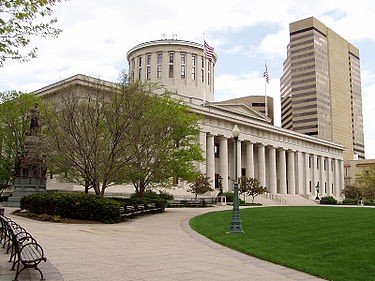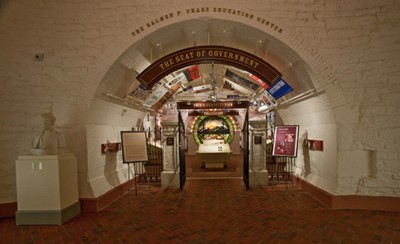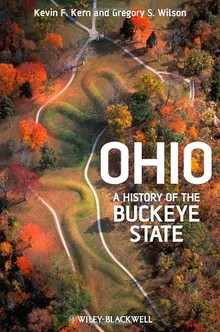This entry includes a walking tour! Take the tour.
Introduction
Text-to-speech Audio
Constructed in stages between 1839 and 1861, the Ohio Statehouse serves as the meeting place of the state legislature and the offices of the governor. The design comes from a competition where the judges selected a structure that blended many of the standard classical features of state legislature buildings and the United States Capitol. Although it features the Greek Revival style, the building does not feature the nearly-ubiquitous dome that became common following the completion of the Capitol Dome in Washington. The State House features Doric columnns made of Columbus limestone from the Scioto River. In addition to skilled workers and supervisors, much of the labor for the building was provided by prisoners. The central feature of the building is the Cupola which provides natural light for the rotunda.
Images
The Ohio State House followed a design submitted by a contest winner. Construction began in 1839 and was not completed until 1861.

The Ohio Statehouse Museum is located on the ground floor of the Ohio Statehouse. The museum is open Monday through Friday from 9:00 a.m. to 4:00 p.m.; Saturday and Sunday from 12 noon to 4:00 p.m.

Ohio: A History of the Buckeye State-Click the link below for more information about this book

Backstory and Context
Text-to-speech Audio
When the state government relocated to the new city of Columbus in 1816, it occupied a modest two-story building on the corner of High and State Streets. In 1838, Ohio's government announced a competition to select the design for a new Statehouse. This strategy was not unusual at the time, as important public buildings such as the U.S. Capitol had resulted from similar contests. From about fifty entries, three winners were selected: first prize was awarded to Henry Walter of Cincinnati, the second to Martin Thompson of New York, and the third to painter Thomas Cole, also of New York. However, the organizing committee responsible for choosing the winners was unable to agree on a final design for construction.
When the cornerstone was laid on July 4, 1839, the commission was still without a final design. Consultation with New York architect Alexander Jackson Davis resulted in a composite design that merged some key features of the three winning entries, but it was rejected as being too expensive. Henry Walter, the first-place winner of the design contest, was chosen to supervise construction of the new capitol building and he began working on another composite design that was based largely on the design of third-place winner, Thomas Cole. It seems likely that Henry Walter was chosen to receive the first premium basically because he was an Ohioan and though the entry submitted by Cole may have been more favored by the commission overseeing the design process, his status as an "outsider" may have been a problem. Cole had a personal friendship with one of the commissioners, a man named William A. Adams who was from Steubenville. Cole's nephew, William Henry Bayless, coincidentally a Steubenville native, was apprenticed in the office of Alexander Jackson Davis.
Work on the building's foundation and lower level had only just begun when the Statehouse project encountered the first of many difficulties. The legislation that made Columbus the official capital city of Ohio was set to expire. While various factions within the government engaged in a debate over relocating the capital to another city, construction of the Statehouse was stopped. Open excavations were refilled with earth, and Capitol Square served as pasture lands for livestock.
The Statehouse remained incomplete and largely neglected until 1848 when construction resumed. This work all but stopped in the summer as a cholera epidemic spread through the area. Comparing plans of the various architects it is apparent that perhaps the most striking change, and one that has endured in the finished building, was the fact that West and Russell eliminated the rounded dome that all previous designers had suggested for the building, instead replacing it with a low conical roof.
A fire consumed the old two-story capitol building in 1852, which created a new urgency to complete the new Statehouse. While some suspected arson, the exact cause of the fire remains a mystery to this day.
The statehouse is built in the Greek revival style, a type of design based on the buildings of Ancient Greece, and very popular in the US from 1820 through the early 1860s. The Greek revival was simple and straightforward and didn't look anything like the revival buildings that were popular in Europe at the exact time period. The statehouse was opened to legislators and the public in 1857 when the House and Senate began meeting in their chambers and most of the offices were occupied. It was completed in 1861, and the statehouse has been a national historic landmark by the secretary of the US Department of the Interior. This honor recognizes the long history of the building and the continued role it will have in the life and lawmaking of the state of Ohio. During the restoration project, original graffiti sketched by some of the Ohio penitentiary prisoners was uncovered. One sketch is a profile of a man's face with the word Badger scrawled above it. By searching records at the Ohio Historical Society, the restoration team was able to locate information about Ephraim Badger who was imprisoned from 1846-1849 for burglary. His record states that he was pardoned in 1849 for service to the state.
Cite This Entry
Admin, Clio and Kathleen Thompson. "Ohio Statehouse and Museum." Clio: Your Guide to History. July 18, 2023. Accessed March 12, 2025. https://theclio.com/entry/6981
Sources
"About the Statehouse." Ohio Statehouse. Accessed December 19, 2016. http://www.ohiostatehouse.org/about/capitol-square/statehouse.
Pitts, Carolyn. "Ohio Statehouse." National Park Service - National Register of Historic Places Nomination Form. July 31, 1972. https://npgallery.nps.gov/GetAsset/36374534-3e30-47c5-9051-d2c5b442558d.

